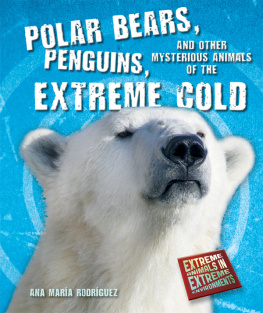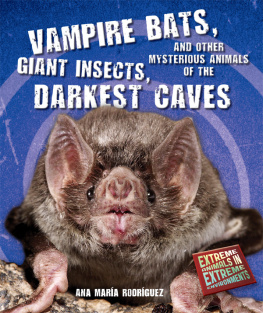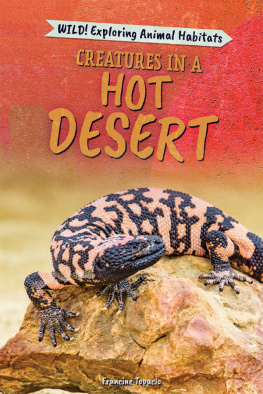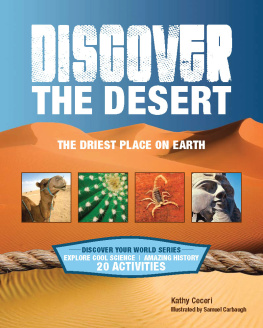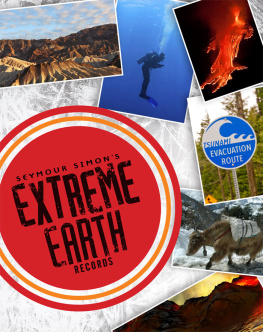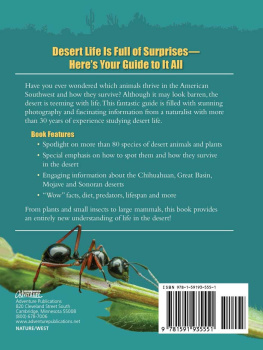EXPLORE THE EXTREME ANIMALS OF THE EXTREME DESERTS!
Exploring the desert is an unforgettable experience. Most days there is not a cloud to shade the blazing sun. Within minutes, exposed skin shows signs of sunburn. Even the sunlight reflected from the ground damages the skin. Hundreds of animal species live in the desert, big and small. How do they survive with so little water, the extreme heat, and a limitedand sometimes toxicfood supply? Author Ana Mara Rodrguez explores many of the amazing animals in this extreme environment.
ABOUT THE AUTHOR
ANA MARA RODRGUEZ was a scientist doing research in immunology and other biological sciences for over twenty years. She is currently a full-time writer with twenty books published.
As far as the eye could see, no trace of vegetation, no plant, not a blade of grass no trace of any animal, no impression from the foot of a living creature in this bare flat ground.
Scientist Jacob H. Schiel describing the salt flats bordering the Great Salt Lake during the Gunnison-Beckwith expedition (1853-1854). This expedition sought out possible routes for the railroad to the Pacific.

Image Credit: 2011 Photos.com
Exploring the desert is an unforgettable experience. Most days there is not a cloud to shade the blazing sun. The air feels extremely dry and hot, like a heat wave coming out of a burning oven. Within minutes, any exposed skin shows signs of sunburn. Even sunlight reflected from the ground can damage the skin.
The body sweats profusely trying to cool down, but its so dry that the water evaporates before it accumulates on the skin. Precious water abandons the body in spite of constant lip licking and rapid blinking to keep the lips and the eyes moist. Dehydration is a clear threat. If there is water somewhere, it might be so salty that its unsafe to drink.

Image Credit: 2011 Photos.com
Spiders are one of many kinds of desert invertebrates.
After a quick search for living creatures, it seems the desert is, well, deserted. Plants are few and far apart. It takes a keen eye to spot a lizard, a rodent, a bird, or an insect. As the sun sets, the temperature drops quickly and the desert becomes more bearable. This is when the desert becomes alive. Careful night explorations reveal a large variety of animals.
Hundreds of animal species live in the desert, big and small. Ants, flies, bees, beetles, butterflies, spiders, scorpions, lizards, snakes, birds, rodents, hares, antelopes, camels, pumas, and coyotes are just some examples of the deserts animals. How do they survive with so little water, the extreme heat, and limited, and sometimes toxic, food supplies?
A desert is a dry or arid land with few and scattered plants. Deserts are dry because they receive little and irregular rain or snow. What little water does fall from the skies quickly evaporates.
In general, deserts receive about ten inches, or 250 millimeters of rain per year. However, there are areas that receive less than one inch of rain annually. These are the most extreme deserts on Earth. The Atacama Desert in South America is an extremely dry desert; it may not rain there for several years in a row.
Deserts cover about one-fifth of the land area on Earth and are found in Asia, Africa, Australia, North America, and South America. Some people even call the cold, dry, barren regions at the North and South Poles deserts, because they receive only a very small amount of annual precipitation.
Many people think that all deserts are large expanses of sand and dunes. About one-fourth of all deserts have large dunes. However, what is more common is ground covered with soil, gravel, or small pebbles. Also located in deserts are dry lakes, or salt pans, where water accumulates briefly during rains and then evaporates leaving a salty crust. There are deserts with tall rock formations sculpted by water and wind while others are surrounded by mountains. Some deserts are at sea level, while others are very high above the sea.
Deserts are known for hot summer days. In the hottest deserts, temperatures may reach 104 Fahrenheit (40 Celsius ) or more for many days in a row. But on a winter night, these deserts sometimes reach temperatures below 32F (0C). In fact, some deserts have very cold winters where it can even snow.
For example, the Atacama Desert in South America and deserts in Asia are cold. They experience day and night temperatures that are much lower than hot desert temperatures. For example, the Pamir Plateau in Asia has an average temperature of 1.4F (-17C), often dropping to -51F (-46C) during winter. July is the warmest month with an average temperature of just 57F (14C).

Image Credit: 2011 Photos.com
Salty rock formations in a pond at Death Valley, which is near the California-Nevada border. The pond is saltier than the ocean.

Image Credit: 2011 Photos.com
Weather stations around the world measure the air temperature. The highest air temperature ever recorded is 136F (57.8C) in the desert of El Azizia, Libya, on September 13, 1922. The lowest temperature ever recorded is -132F (-91C) at the Russian research station at Vostok, Antarctica, in 1997.
Desert creatures are challenged by very limited water supply, extreme heat, bright sun, and often strong winds. Deserts receive very little rain because the air carries little moisture.
When it does rain, it may be for a few days or weeks in a year. Water accumulates in ponds, flat lakes, or creeks. Part of the water seeps underground. It might be stored deep beneath the ground in large deposits. Sometimes rain may be torrential, and the land does not have time to absorb it. Water may run off carrying rocks, soil, and other materials with it. Desert plants and animals have learned to live with the limited water supply. It is during these brief periods of precipitation that plants bloomsometimes painting deserts with rainbow colorsand animals have their young.
The dry air contributes to the intense hot days and cold nights. Moisture in the air absorbs or deflects the suns radiation. But dry air lets much of the suns rays reach the ground and heats it intensely. At night, the warmth of the desert escapes easily through the dry air into space, and the temperature drops significantly.
Low moisture and heat feed back on each other. Heat increases evaporation, which dries the land, and the lack of moisture in the air allows more sunlight to pass through it and heat the ground.
Strong winds and sandstorms are common in the desert. Winds occur because the hot ground warms up the air. As the hot air rises, colder air flows down to take its place. This creates winds that may be fast and strong and create dust or sandstorms. Strong winds limit the time animals have to look for food or water. Wind is one force shaping the desert. The dust it carries can travel a long distance and is often carried out of the desert. Sand, on the other hand, is heavier and cannot be carried as far. Wind can carry it across open lands, but, as the wind slows near mountains or other obstacles, the sand falls and can form large dunes.


